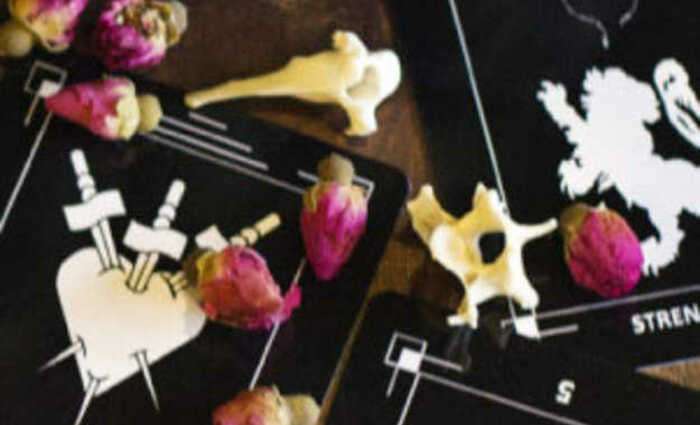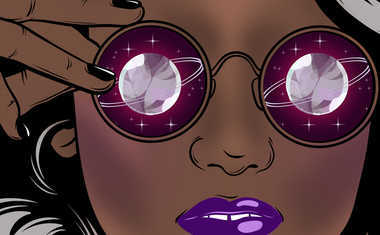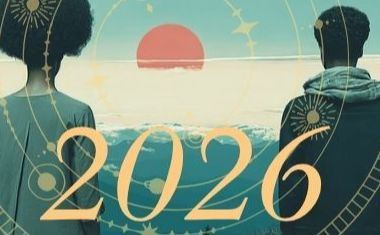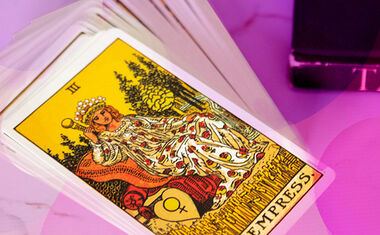
Creating the Dark Exact Tarot
A designer's journey
In the Dark Exact Tarot deck, as with any Tarot deck, readers will find their whole lives. All the opportunities and challenges of existence are described in the Fool’s Journey of the Major Arcana and the four suits of the Minor Arcana.
The Dark Exact Tarot, however, represents the characters of the Major Arcana as plants, animals, objects, and alchemical symbols instead of the traditional human figures, offering readers a chance to explore more personal associations and links to each card’s content. The four suits are represented graphically, with elemental symbols corresponding to each suit providing additional visuals to aid interpretation.
Honoring the Tarot’s traditions
As the designer of this deck, I have to confess, it feels somewhat self-indulgent to create a new Tarot deck... With so many different decks in existence, how could it be possible to improve this already perfect tool for self-study? When I found myself compelled to design a new deck, I realized I wasn’t trying to improve anything; I was honoring this vital system by participating in it at a deeper level, taking everything I had learned about Tarot over the years and reprocessing it, offering a different access point within the canon in hopes it might help others learn the language of Tarot.
Designing an entire deck was daunting at first. I wasn’t entirely sure how to proceed. It turned out to be a gradual building process, starting with the four aces. Because the aces were so clear and important in all the decks I was inspired by, I knew they needed to be presented in a straightforward way. As for rest of the Minor Arcana, I have always been drawn to the design of pip cards -- their beautiful, organized displays of repetition. I wanted to keep that clean sense of structure, but play with how the placement of objects could communicate the meanings in the cards, as it had in the decks that taught me.
I studied the scenes in such classic decks as the Aquarian Tarot and the Rider-Waite; suddenly, the suit symbols seemed to lift off the surface, away from their environments. I saw the cards stripped of any background, and it felt right to see those symbols standing starkly on the page, away from human hands. Classically, decks show these archetypes as human figures, placed in rich, colorful backgrounds full of cultural and environmental symbols. I appreciate the lushness this achieves, but I wanted a different kind of impact. Rather than a gradual sinking in to a scene, I wanted the reader to be immediately confronted by the cards. The stark design grabs the eye and holds it without scenic distraction, leading directly to visual association -- the first step in interpretation. The added elemental symbols enhance the connection of each suit to its human domain, the realm of existence it rules: mental (Swords), emotional (Cups), material (Pentacles), spiritual (Wands).
Get a reading using the Dark Exact Tarot deck now »
Objects as archetypes
As I turned my attention to the characters of the Major Arcana, I realized more about my impulses to simplify the imagery. The real dilemma for me? Faces. Who were these people? Deck after deck presented me with, more or less, the same faces. I didn’t feel any affinity for them, couldn’t imagine myself as them or interacting with them during my Fool’s Journey. Instead, I thought about how each step along my journey so far has been marked by an object of some kind. This is such a common practice -- humans are collectors.
Our lives are expressed in an assortment of souvenirs. From airport gift shop shotglasses, to precious family heirlooms, to trinkets from childhood, our saved objects remind us of what we experienced and learned. We keep them to remind us of who we have been and how we have -- or haven’t -- changed. We demonstrate and secure identity, individual or collective, in the things we amass around us. Instead of using human figures to represent the archetypal stages of development in the Journey, I chose to use important objects, plants, and creatures from the collection of my life.
Get a reading using the Dark Exact Tarot deck now »
Inspired by the past
This meant the deck would be more personal than I’d originally intended. I mined past artwork to see what symbols I obsessed over. I looked back to my mother’s and my grandmother’s gardens and saw many same plants growing in my yard now. I looked at the shelves in my room cluttered with objects, each one a marker of an idea. I began to draw and combine. The symbols spoke to each other, often presenting themselves so intuitively I had to analyze the impulse after the fact to discover the connections to the Major archetypes. It was not important to me to be direct in depicting each character; it was essential to capture their spirits.
 For example, my Temperance card features a graphic of a trout lily, an early spring wildflower found commonly in the Midwestern U.S. woods. The flower image was taken from a sunprint of a trout lily I’d picked and pressed in my botanical journal while living in that region nearly 20 years ago. These modest but beautiful flowers appear like little white angels on the forest floor for a very short time each year, then fade. But with no cultivation or other human prompting (only the go-with-the-flow of Nature), they return like clockwork the next year. What a perfect example of perpetual patience, of yielding to the natural course of things -- in my mind, the most important lesson of this card. The pentacle situated above the flower, a symbol of harmony to the alchemists, was used to anchor the card both visually and conceptually. My card design honors the traditional aspects of Temperance as well as a place and time that was crucial to my development as an artist and a person.
For example, my Temperance card features a graphic of a trout lily, an early spring wildflower found commonly in the Midwestern U.S. woods. The flower image was taken from a sunprint of a trout lily I’d picked and pressed in my botanical journal while living in that region nearly 20 years ago. These modest but beautiful flowers appear like little white angels on the forest floor for a very short time each year, then fade. But with no cultivation or other human prompting (only the go-with-the-flow of Nature), they return like clockwork the next year. What a perfect example of perpetual patience, of yielding to the natural course of things -- in my mind, the most important lesson of this card. The pentacle situated above the flower, a symbol of harmony to the alchemists, was used to anchor the card both visually and conceptually. My card design honors the traditional aspects of Temperance as well as a place and time that was crucial to my development as an artist and a person.
In 2017 I released a full guidebook for The Dark Exact Tarot. In it the cards are explained in greater detail, providing readers information about the layered symbolism in each card and the logic that went into illustrating the characters as I did. My hope is that even without these detailed explanations the symbols suggest their meanings on some level, allowing for readers’ personal associations with the imagery to guide them to a greater relationship with the cards.



